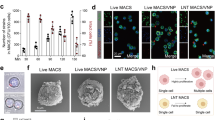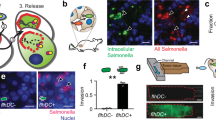Abstract
Systemically administered tumor-targeted Salmonella has been developed as an anticancer agent, although its use could be limited by the potential induction of tumor necrosis factor α (TNFα)-mediated septic shock stimulated by lipid A. Genetic modifications of tumor-targeting Salmonella that alter lipid A and increase safety must, however, retain the useful properties of this bacteria. We report here that disruption of the Salmonella msbB gene reduces TNFα induction and increases the LD 50 of this pathogenic bacteria by 10,000-fold. Notwithstanding this enormous difference, Salmonella retains its tumor-targeting properties, exhibiting tumor accumulation ratios in excess of 1000:1 compared with normal tissues. Administration of this bacteria to mice bearing melanoma results in tumors that are less than 6% the size of tumors in untreated controls at day 18. Thus, the antitumor activity previously demonstrated using tumor-targeting Salmonella with normal lipid A is retained. Lipid modification of tumor-specific bacterial vectors provides a means for reducing septic shock and further suggests that the antitumor activity of these bacteria may be independent of TNFα.
This is a preview of subscription content, access via your institution
Access options
Subscribe to this journal
Receive 12 print issues and online access
$209.00 per year
only $17.42 per issue
Buy this article
- Purchase on Springer Link
- Instant access to full article PDF
Prices may be subject to local taxes which are calculated during checkout





Similar content being viewed by others
References
Pawelek, J., Low, K.B., and Bermudes, D. 1997. Tumor-targeted Salmonella as a novel anti-cancer vector. Cancer Res. 57: 4537–4544.
Bone, R.C. 1992. Toward an epidemiology and natural history of SIRS (systemic inflammatory response syndrome). J. Am. Med. Assoc. 268: 3452–3455.
Dinarello, C.A., Gelfand, J.A., and Wolff, S.M. 1993. Anticytokine strategies in the treatment of the systemic inflammatory response syndrome. J. Am. Med. Assoc. 269: 1829–1835.
Flad, H.-D., Loppnow, H., Rietschel, E.T., and Ulmer, A.J. 1993. Agonists and antagonists for lipopolysaccharide-induced cytokines. Immunobiology 187: 303– 316.
Kovach, N.L., Yee, E., Munford, R.S., Raetz, C.R.H., and Harlan, J.M. 1990. Lipid IVA inhibits synthesis and release of tumor necrosis factor induced by lipopolysaccharide in human whole blood ex vivo. J. Exp. Med. 172: 77–84.
Rick, P.D. and Osborn, M.J. 1977. Lipid A mutants of Salmonella typhimurium: Characterization of a conditional lethal mutant in 3-deoxy-D-mannooctulosonate-8-phosphate synthetase. J. Biol. Chem. 252: 4895–4903.
Engel, H, Smink, A.J., van Wijngaarden, L., and Keck, W. 1992 Murine-metabolizing enzymes from Escherichia coli: Existence of a second lytic transglycosylase. J. Bacteriol. 174: 6394–6403.
Karow, M. and Georgopoulos, C. 1992 Isolation and characterization of the Escherichia coli msbB gene, a multicopy suppressor of null mutations in the high-temperature requirement gene htrB. J. Bacteriol. 174: 702 –710.
Somerville, J.E., Cassaiano, L. Jr., Bainbridge, B., Cunningham, M.D., and Darveau, R.P. 1996. A novel Escherichia coli lipid A mutant that produces an antiinflammatory lipopolysaccharide. J. Clin. Invest. 97: 359–365.
Clementz, T., Zhou, Z., and Raetz, C.R.H. 1997. Function of the Escherichia coli msbB gene, a multicopy suppressor of htrB knockouts, in the acylation of lipid A. J. Biol. Chem. 272: 10353–10360.
Khan, S.A., Everest, P., Servos, S., Foxwell, N., Zähringer, U., Brade, H. et al. 1998. A lethal role for lipid A in Salmonella infections. Mol. Microbiol. 29: 571– 579.
Carrier, M.J., Chatfield, S.N., Dougan, G., Nowicka, U.T.A., O'Callaghan, D., Beesley, J.E. et al. 1992. Expression of human IL-1β in Salmonella typhimurium. A model system for the delivery of recombinant therapeutic proteins in vivo. J. Immunol. 148: 1176–1181.
Eisenstein, T.K., Bushnell, B., Meissler, J.J. Jr., Dalal, N., Schafer, R., and Havas, H.F. 1995. Immunotherapy of a plasmacytoma with attenuated Salmonella. Med. Oncol. 12: 103–108.
Saltzman, D.A., Heise, C.P., Hasz, D.E., Zebede, M., Kelly, S.M., Curtiss, R. III et al. 1996. Attenuated Salmonella typhimurium containing interleukin-2 decreases MC-38 hepatic metastases: a novel anti-tumor agent. Cancer Biother. and Radiopharm. 11: 145– 153.
Saltzman, D.A., Katsanis, E., Heise, C.P., Hasz, D.E., Kelly, S.M., Curtiss, R. III et al. 1997. Patterns of hepatic and splenic colonization by an attenuated strain of Salmonella typhimurium containing the gene for human interleukin-2: a novel tumor agent. Cancer Biother. Radiopharm. 12: 37– 43.
Hoiseth, S.K.J. and Stocker, B.A.D. 1981. Aromatic-dependent Salmonella typhimurium are non-virulent and effective as live vaccines. Nature 291: 238–239.
Hohmann, E.L., Oletta, C.A., and Miller, S.I. 1996. Evaluation of a phoP/phoQ -deleted, aroA-deleted live oral Salmonella typhi vaccine strain in human volunteers. Vaccine 14: 19 –24.
Cardenas, L. and Clements, J.D. 1993. Stability, immunogenicity and expression of foreign antigens in bacterial vaccine vectors. Vaccine 11: 126–135.
Chabalgoity, J.A., Khan, C.M.A., Nash, A.A., and Hormaeche, C.E.A. 1996. Salmonella typhimurium htrA live vaccine expressing multiple copies of a peptide comprising amino acids 8-23 of herpes simplex virus glycoprotein D as a genetic fusion to tetanus toxin fragment C protects mice from herpes simplex virus infection. Mol. Microbiol. 19: 791–801.
Galan, J. and Curtiss, R III . 1989 . Virulence and vaccine potential of phoP mutants of S. typhimurium. Microbial Path. 6: 422 –433.
Gonzales, C., Hone, D., Noriega, F.R., Tacket, C.O., Davis, J.R., Losonsky, G. et al. 1994. Salmonella typhi vaccine strain CVD904 expressing the circumsporozoite protein of Plasmodium falciparum: strain construction and safety and immunogenicity in humans. J. Infect. Dis. 169: 927–931.
McSorley, S.J., Xu, D., and Liew, F.Y. 1997. Vaccine efficacy of Salmonella strains expressing glycoprotein 63 with different promoters. Infect. Immun. 65: 171–178.
Su, G-F., Brahmbhatt, H.N., deLorenzo, V., Wehland, J., and Timmis, K.N. 1992. Extracellular export of shiga toxin B-subunit/haemolysin A (C-terminus) fusion protein expressed in Salmonella typhimurium aroA-mutant and stimulation of B-subunit specific antibody responses in mice. Microbial. Pathogenesis 13: 465–476.
O'Callaghan, D., Maskell, D., Liew, F.Y., Easmon, C.S.F., and Dougan, G. 1988. Characterization of aromatic- and purine-dependent Salmonella typhimurium: Attenuation, persistence, and ability induce protective immunity in BALB/c mice. Infect. Immun. 56: 419–423.
Bone, R.C. 1993. Gram-negative sepsis: a dilemma of modern medicine. Clin. Microbiol. Rev. 6: 57– 68.
Ciacci-Woolwine, F., Blomfield, I.C., Richardson, S.H., and Mizel, S.B. 1998. Salmonella flagellin induces tumor necrosis factor alpha in a human promonocytic cell line. Infect. Immun. 66: 1127–1134.
Streilein, J.W. 1995. Unraveling immune privilege. Science 270: 1158–1159.
Russell, C.B., Thaler, D.S., and Dalhlquist, F.W. 1989. Chromosomal transformation of Escherichia coli recD– strains with linearized plasmids. J. Bacteriol. 171: 2609– 2613.
Davis, R.W., Botstein, D., and Roth, J.R. 1980. Advanced bacterial genetics . Cold Spring Harbor Laboratoy Press, Cold Spring Harbor, NY.
Galanos, C., Luderitz, O., and Westphal, O. 1969. A new method for the extraction of R lipopolysaccharides. Eur. J. Biochem. 9: 245–249.
Apicella, M.A., Griffiss, J.M., and Schneider, H. 1994. Isolation and characterization of lipopolysaccharides, lipoligosaccharides, and lipid A. Methods Enzymol. 235: 243–252.
Sklar, M.D., Tereba, A., Chen, B.D., and Walker, W.S. 1985 . Transformation of mouse bone marrow cells by transfection with a human oncogene related to c-myc is associated with the endogenous production of macrophage colony stimulating factor 1. J. Cell Physiol. 125: 403–412.
Elsinghorst, E.A. 1994. Measurement of invasion by gentamycin resistance. Methods Enzymol. 236: 405– 420.
Acknowledgements
We thank Jean Bolognia, Keith Joiner, and Terry Doyle for helpful discussions. This work was supported by Vion Pharmaceuticals, Inc.
Author information
Authors and Affiliations
Corresponding author
Rights and permissions
About this article
Cite this article
Low, K., Ittensohn, M., Le, T. et al. Lipid A mutant Salmonella with suppressed virulence and TNFα induction retain tumor-targeting in vivo. Nat Biotechnol 17, 37–41 (1999). https://doi.org/10.1038/5205
Received:
Accepted:
Issue Date:
DOI: https://doi.org/10.1038/5205
This article is cited by
-
Synthetic biology-inspired cell engineering in diagnosis, treatment, and drug development
Signal Transduction and Targeted Therapy (2023)
-
A programmable encapsulation system improves delivery of therapeutic bacteria in mice
Nature Biotechnology (2022)
-
Intracellular delivery of protein drugs with an autonomously lysing bacterial system reduces tumor growth and metastases
Nature Communications (2021)
-
Enhancing the tropism of bacteria via genetically programmed biosensors
Nature Biomedical Engineering (2021)
-
Bacteria-Mediated Synergistic Cancer Therapy: Small Microbiome Has a Big Hope
Nano-Micro Letters (2021)



